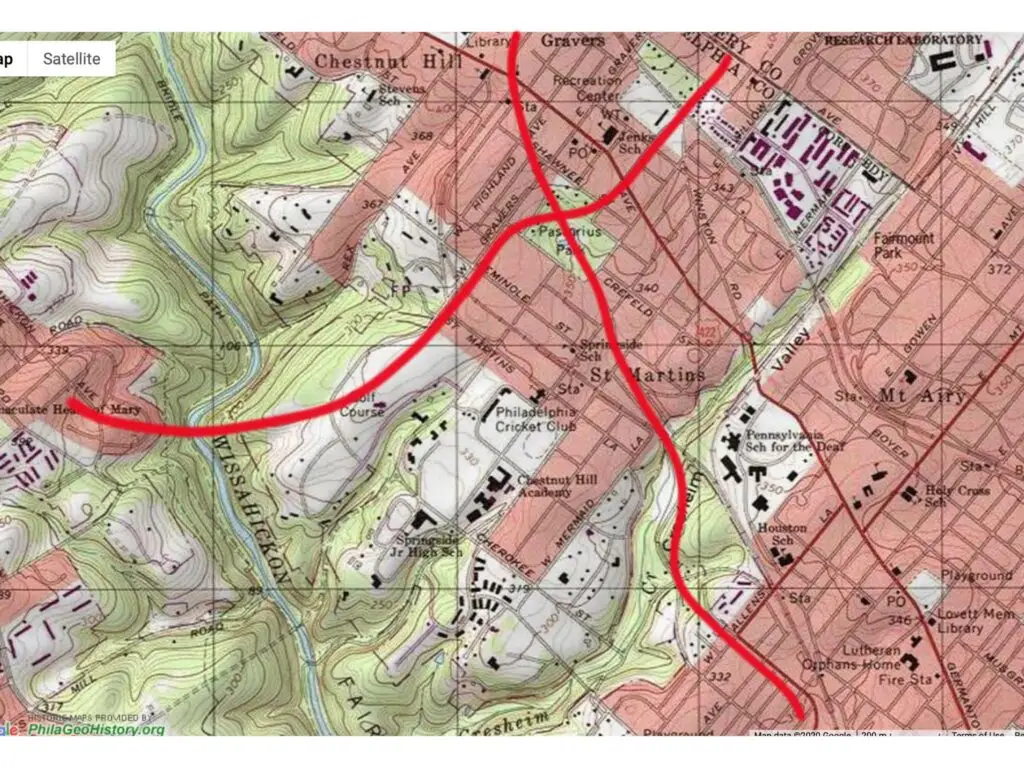Park History
Timeline
1913 - 1914
Pastorius Park’s Unlikely Origins
In the early 1870’s, Frederick Law Olmsted coined the term ‘Parkway’ and designed the first example of its kind—a green, access-limited thoroughfare that unified the rapidly-developing borough of Brooklyn, NY. Olmsted would live long enough to witness the widespread adoption of the parkway idea as a response to the coming of the Automobile Age.
As early as 1900, the city of Philadelphia began planning Lincoln Drive, a parkway that would link Center City to Chestnut Hill. Following soon were regional plans for a Cross Country Highway intended to connect Northwest Philadelphia with both the Main Line and Montgomery County.
The two roads would intersect at a large double roundabout in the heart of Chestnut Hill. By 1914, acquisition and eminent-domain condemnation of land for this intersection was underway.
Dr. George Woodward, intending to develop new neighborhoods around the intersection and along the route of the proposed Cross Country Highway, hired the Olmsted firm to refine (what he considered to be) the municipalities’ heavy handed alignment.

1914
Connections to the Region
The parkway design that Dr. Woodward commissioned would have followed a westerly extension of Hartwell Lane that required raising the Pennsylvania Railroad trackbed between St. Martin’s and Highland Stations.
A consortium of alarmed homeowners lining the right of way separately hired the Olmsted Brothers to find an alternative.
The designers’ solution diverted the Cross Country Highway southwest to follow the route of Gravers Lane and duck under the tracks, thus avoiding any substantial change to the railroad and to its neighbors’ quality of life.
Meanwhile, Dr. Woodward, fully approving of this alternative, directed the Olmsteds to explore the layout for a subdivision huddled around a simple intersection to replace the originally envisioned large roundabout.

1916 - 1921
Pastorius Park Village
During the two years following the early large-scale planning of the west side of Chestnut Hill, the boundaries of Pastorius Park (still in the form of a landscaped intersection) were fixed, and fully a third of the picturesque village projected to surround it was built, photographed, and written up in the architectural press. Hartwell Lane returned as the preferred alignment of the Cross Country Highway, now projected to bridge over the barrier of the nearby commuter railroad. A scaled-down version of the original roundabout returned as Pastorius Park’s central feature.
America’s entry into World War I in April, 1917 and the 1918 arrival of a worldwide influenza pandemic stalled further efforts to build and join the two planned parkways and to finish detailed design for the Park’s remaining open space.

1921
Stop-Gap Planting
In the spring of 1919, the future park remained an undeveloped, trash-strewn and weed-infested wasteland. Early rough grading for the intersecting roadways lay abandoned and unfinished. Assuming that the Park would ultimately be built as conceived, but frustrated with its unkempt condition, Dr. Woodward undertook at his own expense to add plantings that would improve it without being in the way of future construction.
His initiative began with a spur-of-the moment and hastily-written note to landscape architect Frederick Dawson, designer of the gardens and grounds of Krisheim—the Woodwards’ estate—and their longtime consultant.
Dawson visited the site and doodled a response on the back of Woodward’s note.
Two years passed before the doodle took the form of a planting plan and list. Finally, in the spring of 1921 the scheme—hundreds of deciduous and evergreen trees making an instant dense screen along the Park’s borders—was fulfilled. That project, minus its Red Pines (a species decimated country-wide by pine scale) stands in maturity today, one hundred years after it was planted.

1932 - 1935
The New Deal to the Rescue
It is not yet known why after 1921 the Park sat unfinished for a full ten years. The cause was likely an inability to conquer the challenging logistics of designing and building the several roads meant to converge there.
During that decade, and as late as 1931, the Woodwards twice paid the Olmsted Brothers firm to refine the original concept, with its central intersection and park-like setting.
In the end, suddenly, full funding—from the rescue programs of the New Deal—was available for the comprehensive and detailed design and construction of a classic naturalistic, picturesque pedestrian park. The Olmsted firm withdrew, and Fred Peck, a young landscape architect, was given the opportunity to design the beloved landscape that remains today

1987 - Present
Neighborhood Stewardship
Pastorius Park at its completion in 1935 was a gem of American pastoral park design. Fifty years later it was in serious decline. Beginning in early 1987 there were stirrings of a renovation, but these involved extensive security lighting and the introduction of paved pathways. Community response was immediate and emphatic: no lights, no asphalt. That spring, with the considerable support and encouragement of Dr. George Woodward’s granddaughter, Quita Woodward Horan, a core group of neighbors came together to found the Friends of Pastorius park.
For thirty-five years the Friends have marshaled volunteers and taken on the responsibility for maintaining and improving the Park.
Pastorius park history information contributed by Robert J. Fleming, ASLA. Courtesy, Chestnut Hill Conservancy.

Support Your Park
DONATE OR VOLUNTEER TODAY!
Pastorius Park relies on community support to maintain the health and safety of this historic landscape. Your support enables FoPP to continue caring for the trees, historic plantings, water systems, and structures within the park. Show your support through a donation to Friends of Pastorius Park or joining us as a volunteer.



